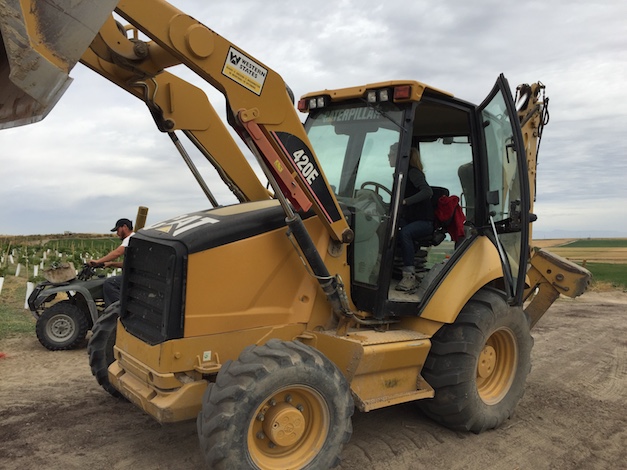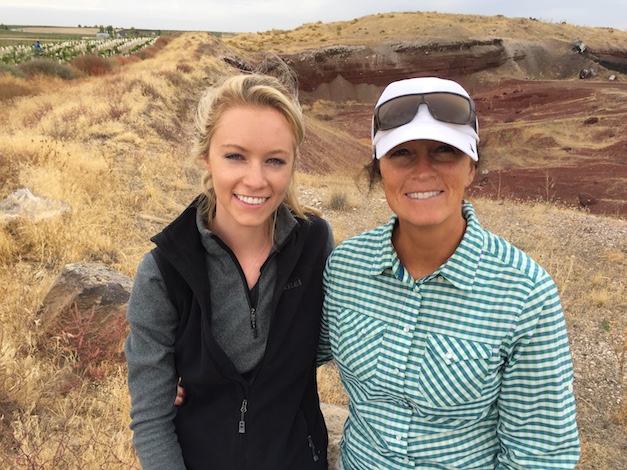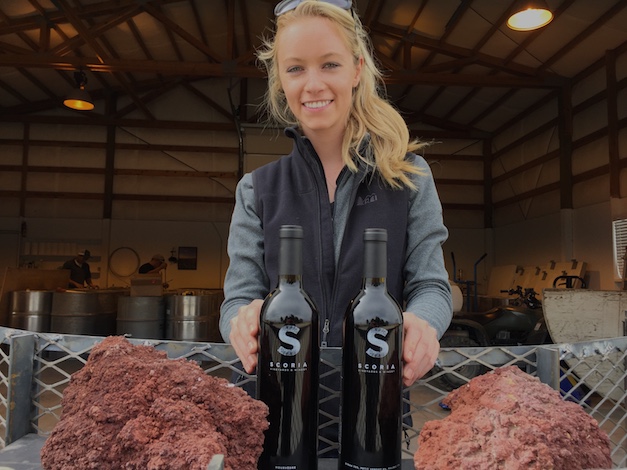
CALDWELL, Idaho – It’s all come together in a short period of time, but young Idaho vintner Sydney Nederend will pull off fruit from the 2016 vintage for the first estate wines under her new Scoria Vineyards and Winery project.
She’s partnered with two of Idaho’s top winemakers in Greg Koenig and Earl Sullivan. Her family has been farming in the Snake River Valley for a century, and the home for her planned 100 acres of vineyard ranks among the state’s sweetest sites.
“I got my degree in finance from Boise State and planted the first vineyard actually before I was done with my degree and before I was 21,” Nederend said. “I couldn’t even drink wine at that point.
“I told my husband, ‘We should probably start drinking some wine,” she chuckled. “I’ve come a long ways since then.”
This fall, at the age of 23, she’s opening her industrial-chic tasting room for Scoria between Lake Lowell and the Snake River. She shares the corrugated steel building with a portion of her parents’ mint oil operation.
Last month, we met Nederend in the Snake River Valley and toured Scoria’s tasting room and vineyards.
Here’s the interview:
[powerpress]
A blank slate for Scoria Vineyards

Nederend attended a private high school and sailed through Boise State’s College of Business and Economics, but leaving the Treasure Valley and turning her back on the Weitz family farming business seemed out of the question. Her husband, James Nederend, is a dairyman in his family’s business in nearby Marsing.
“I wanted my own business and I had access to all of the equipment and my family has a lot of knowledge with growing complicated crops, so I felt comfortable,” she said. “I really just jumped into this. The wine part developed as I was getting into the vineyards. It all happened pretty fast, to be honest.”
Farming and hard work runs in the family. Her father, Joe Weitz, is one of the state’s leading mint oil producers. And on this day, Sydney and her mother, Kristen, take turns operating a Caterpillar as they hang wires for trellising 9 acres of new vineyard. A dental hygienist while her daughters were going through school, Kristen didn’t seem to mind giving up her tennis match on this day.
“She is great,” Sydney said. “She just totally jumps in, and she’ll be here all day.”
If not for corn harvest, James probably would have pitched in, too.
“He definitely helps when I need him to, for sure,” Sydney chuckled.
And then there’s Murphy, an Australia shepherd the Nederends rescued. He’s a fiend for fetching any stick you can find in the vineyard to fling.
A new crop for fourth generation

In the case of Scoria Vineyards, this was a rare instance when land was the easiest part of the equation.
“This piece of property was the first one to be bought by my great grandfather, so it’s been in the family for almost 100 years,” Nederend said. “My family moved here from Los Angeles. They were in the fruit business, and a lot of this area was planted in pears. They called it Pear Hill.
“They started moving away from orchards and getting into crops,” she continued. “A lot of what my family grows now is spearmint and peppermint. The mint is just south of the vineyards, and that’s where they process the leaves and extract the oil. That’s what my family has been doing for the past 15 years, and we’re starting to move into the grapes.”
Growing mint requires signification crop rotation. A handful of years of production requires more than a decade of growing something else to recondition the soil. Ironically, Brad Pintler, who established Sawtooth Vineyard and later sold it to Precept, now farms more than 500 acres of mint.
Dale Jeffers, who worked with Pintler, serves as vineyard manager at Skyline Vineyard, the largest in Idaho and another site controlled by Precept.
“I met with Dale Jeffers and talked to him about what he had planted,” Nederend said. “He obviously has a ton of experience with what varieties work well. I knew this site was really good for reds, so I’ll only plant reds up here.”
So in 2014, the Weitz family began with Malbec and Petit Verdot. There’s already a chapter of success with Malbec in the Snake River Valley, but that didn’t factor into this first direction for Scoria.
“My family really likes Malbec and Petit Verdot,” Nederend said with a chuckle. “I wasn’t able to drink then, but I knew what they tasted like.”
The story behind scoria

There’s a good reason why the three previous generations of Weitzes left this 250-acre portion of their holdings in its natural state, a shrub-steppe community populated by green rabbitbrush.
“It’s a site that’s never been touched ever before,” she said. “We had to apply to get the water rights for it. “
The soil was too poor to support orchards, too rocky and irregular for traditional row crops. However, Nederend saw potential in this almost lunar landscape and crushed cinder-red earth – beyond running cattle on it.
“The scoria rock pit was a volcanic vent. My family excavated the scoria rock and used it as insulation for cold storage, and through the excavating exposed this volcanic vent,” she said. “That’s the whole reason behind the name Scoria. That’s the geological term for that type of rock that’s up here. It lines the roads. We faced massive scoria rocks and basalt rocks as we planted the new site. They are all over the place.”
That pit — there’s a similar formation at Sawtooth Vineyard — is a fascinating feature at Scoria Vineyards and a natural hook for wine club events.
A growing market for grapes

Earlier this year, the Idaho Statesman published a front-page photo of Nederend standing within her inaugural 2014 planting. That recognition and story in the business section generated notes of congratulations from friends and made her parents proud.
“They are so supportive. They are really investing in my business and my future. They help out a lot. I couldn’t do it without them,” she said. “It’s really nice for my dad because he can actually show up at the vineyard and things are taken care of, whereas on the farm that’s his responsibility. I think he enjoys being able to relax a bit when he comes up to the vineyards.”
And now there’s a trickle of return on their investment as the 100 cases of those inaugural bottlings of Scoria wine are now hitting the market. That’s also helped allay fears of her father.
“Oh yeah, definitely,” Nederend chuckled. “Now that I’m finally selling it.”
Forging winemaking relationships

Ask any Idaho winemaker for the biggest problem their industry faces and they will tell you it comes down to 50 wineries vying for 1,300 acres of Gem State fruit. That begins to explain why a sizeable portion of Scoria grapes ends up in cellars at nearby Koenig Vineyards and Telaya Wine Co., in the Boise suburb of Garden City.
Nederend reached out first to Koenig, who has been making wine in Idaho for two decades and knew of her family’s storied success as farmers.
“I kind of flagged him down in his vineyard,” Nederend recalled with a smile. “I needed to figure out how to get the trellising in at my site. I had no idea, so I needed to find this guy.
“I asked him if he needed any help in the vineyards, and he didn’t, but he needed help in the tasting room,” she added. “So I started working in the tasting room.”
Nederend spent a year at Koenig Vineyards while tending her 9 acres of young Malbec and Petit Verdot vines. This year, Scoria planted Cabernet Sauvignon and Merlot, taking her beyond 17 acres of vineyard.
“Once I established the relationships with Koenig and Telaya, they were interested in my fruit so I’m going to be working exclusively with them for where my fruit goes,” she said. “Half of it goes to Koenig, and then at Telaya, half of it is used for their wine and half of it is for me.”
As part of the 2016 vintage, she’s instructed both wineries to create a 100 percent Malbec and a 100 percent Petit Verdot.
“It will be two totally different styles of winemaking,” she said. “Telaya’s version for me is in French oak, and what I’m making with Koenig is going to be in American. And the fruit that was picked for Telaya was picked about 2 1/2 weeks earlier than the fruit that’s being picked with Koenig, so there’s going to be some major differences.”
Flipping switch on Scoria’s tasting room

This fall, Nederend opened her Walker Lake Road tasting room first to family and friends. The ultimate attractions are the two reds made for her by Sullivan — a 2013 Syrah-based blend and a 2013 Mourvedre. Both came from Skyline Vineyard, the bread basket for the Idaho wine industry.
However, she’s also proud of the huge and eclectic lighting fixture that hangs from the ceiling and serves as the centerpiece of her tastefully simple tasting room and aligns with her “S” logo.
“It actually turned out to fit my brand really well,” she said. “It’s really contemporary and all centered around this massive dome light that was at a furniture store in downtown Boise for 15 years and never sold.
“When the business sold and closed their doors, they didn’t have anywhere to put this almost spaceship 6-foot by 6-foot light.”
The future landscape for Scoria

Less than a mile from the vineyard and standing on the site of what someday will be the permanent tasting room for Scoria, it’s clear to see the potential that’s already surrounded by natural beauty. There’s the Snake River to the west and the craggy peaks of the Owyhee Mountains to the south.
And 45 minutes to the east is downtown Boise with more than 215,000 residents. Economists peg the Boise Valley’s population at 675,000.
“A lot of people are getting interested in Idaho wine,” she said. “There’s a lot of really good winemakers here. I think Greg Koenig and Martin Fujishin and Earl (Sullivan) at Telaya are really on the forefront of some really great winemaking.”
When her plantings span 100 acres and come into full production, Scoria Vineyards could easily reach 20,000 cases worth of wine. Split among Koenig and Telaya wineries, Scoria might be a 10,000-case brand. And Nederend will only be in her early 30s.
“The marketing and design aspect is what I really love,” she said. “The farming part is a lot of fun. That’s definitely more challenging for me, but I have more of a creative mind, so it’s really nice for me to be able to use the business and the creativity and the ag all in one.
“It’s really what I’m meant to be doing in life,” she added. “I’m lucky that I found it when I’m so young.”

Leave a Reply